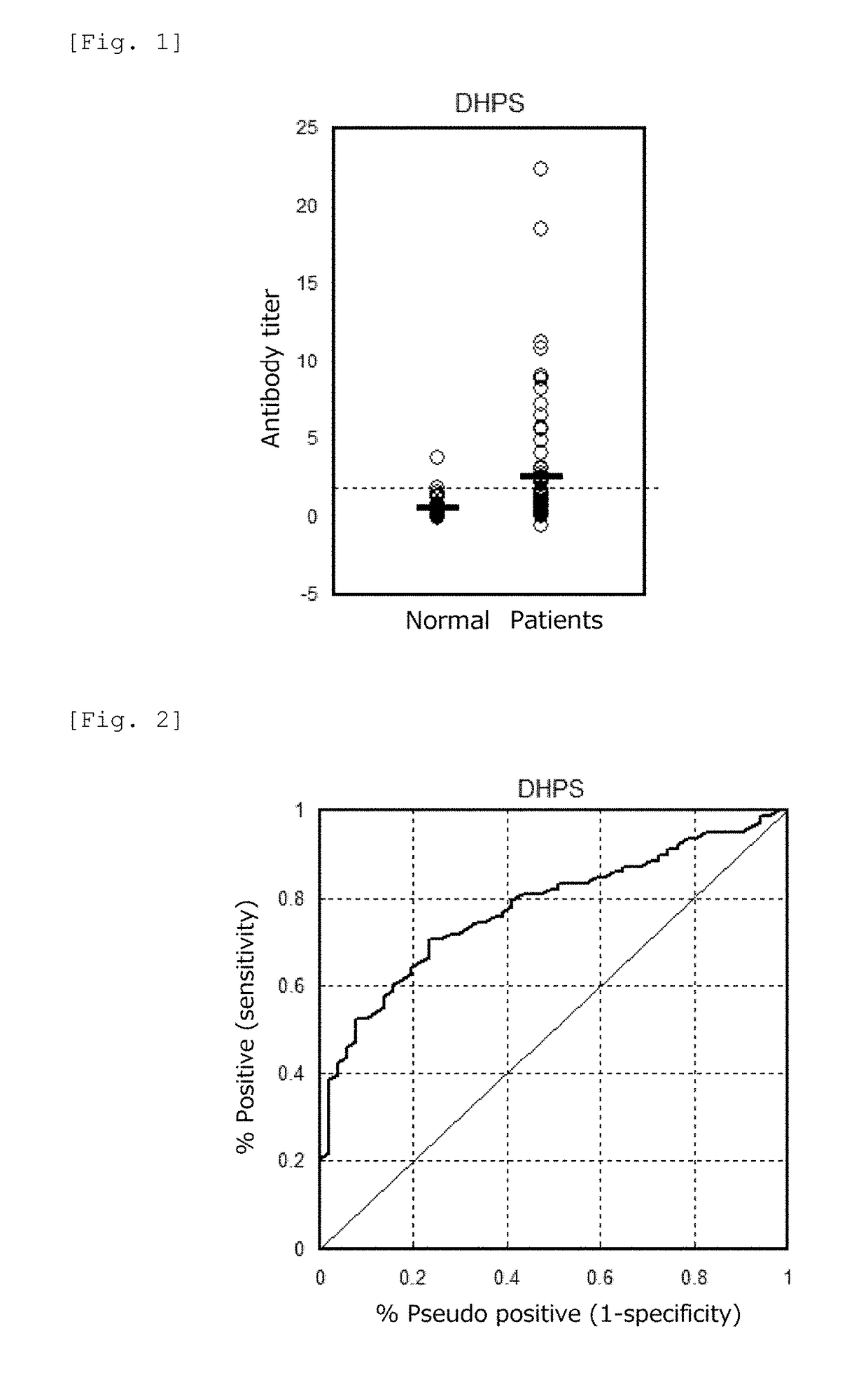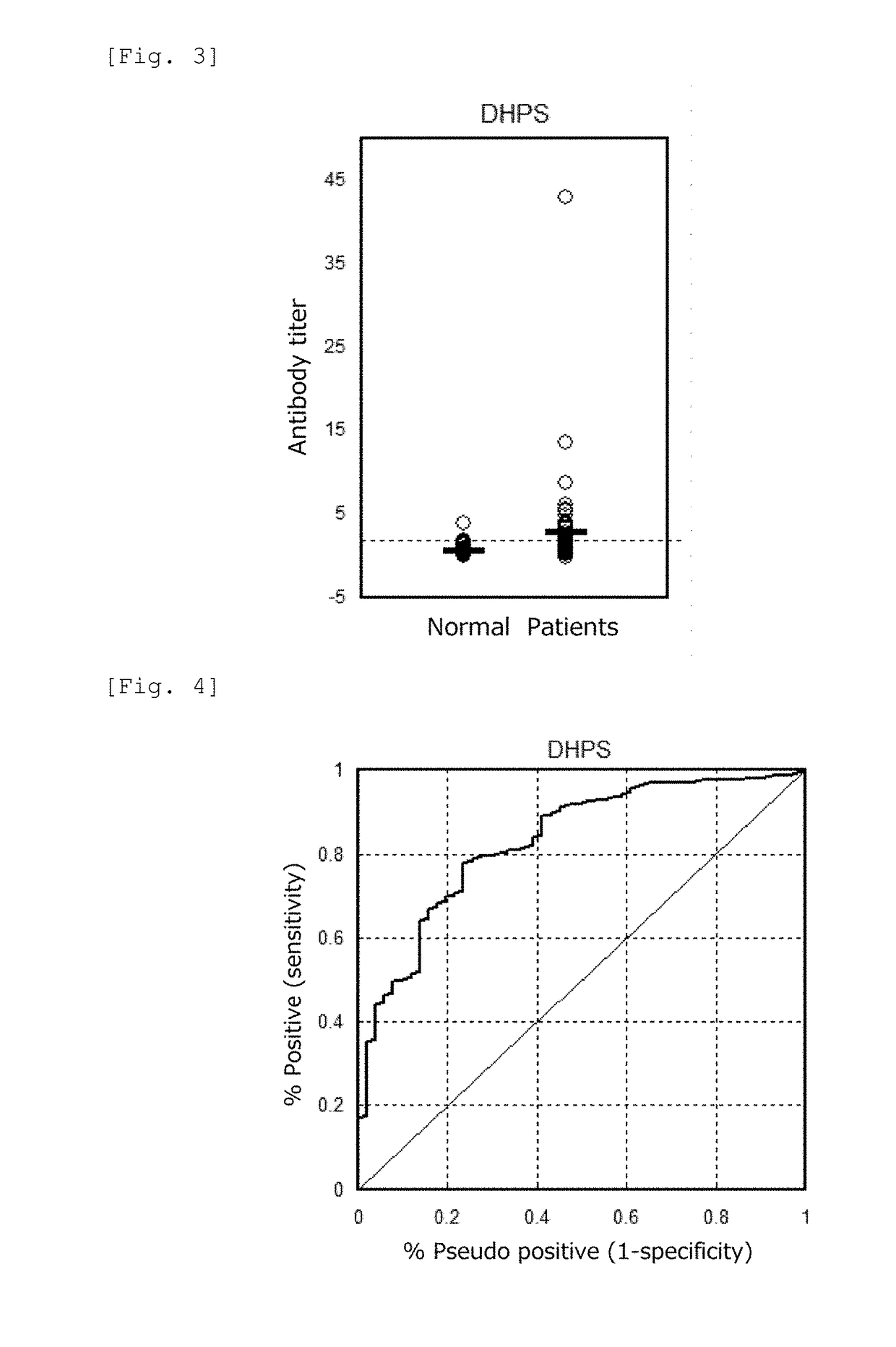Arteriosclerosis and cancer detection method using deoxyhypusine synthase gene as indicator
a deoxyhypusine synthase and gene technology, applied in the field of arteriosclerosis markers, can solve problems such as difficulty in finding a specifi
- Summary
- Abstract
- Description
- Claims
- Application Information
AI Technical Summary
Benefits of technology
Problems solved by technology
Method used
Image
Examples
examples
[0129]The present invention will next be described by way of examples.
[A] Arteriosclerosis Determination Method of the Present Invention
[Reference Example] Screening of DHPS as Arteriosclerosis Marker
[0130](1) Blood serum specimens of arteriosclerosis patients and a healthy subject were brought into contact with a protein array on which about 8,000 proteins were immobilized. Autoantibodies which are intrinsic to arteriosclerosis patients and which are present in the specimens were detected through indirect immunofluorescence. As a result, about 150 autoantibody candidates were specified. A certain species of the candidates is an autoantibody against DHPS in a serum specimen. The serum specimens of the arteriosclerosis patients were obtained from carotid artery stenosis patients diagnosed by a hospital and other facilities relating to the research.
[0131]The above assessment of the patients employed a control group including normal test subjects (n: almost the same as the number of ar...
example a-1
[Example A-1] Studies on Autoantibody Through ELISA
[0136]Studies through ELISA were performed three times.
(a) Studies on Autoantibody Through ELISA (1)
[0137]Serum specimens of acute cerebral infarction patients (78 cases) and those of healthy subjects (51 cases) obtained from a medical facility A were employed. FIGS. 1 and 2 show the results. FIG. 1 is a graph showing DHPS autoantibody titers of serum specimen of acute cerebral infarction patients (patient group) and healthy subjects (normal group), with distribution profiles thereof. FIG. 2 is a graph showing ROC (receiver operation characteristic) curves regarding the distribution profiles.
[0138]Table 1 shows the statistical test results obtained from FIGS. 1 and 2. As shown in Table 1, the cut-off value was found to be about 0.69, represented by a dotted line in FIG. 1.
TABLE 1NormalNo. of specimens51Average0.57SD0.63Cut-off0.69PatientsNo. of specimens78Average.2.62SD3.87ResultsP value% Positive69%
[0139]The P value was smaller tha...
example a-2
[Example A-2] Studies on Autoantibody Through Western Blotting
[0150]An insert was produced through the procedure shown in Reference Example (2) above, and purified proteins were produced in the same manner. In a specific procedure, a primer having a restriction enzyme recognition site suited for gene recombination to an expression vector pET28 or pGEX-4T was produced in advance. Reverse transcription PCR was carried out by use of RNA extracted from osteosarcoma cell line U2-OS as a template, to thereby yield cDNA, and PCR was repeated, to thereby produce a full-length insert. The thus-produced insert and an expression vector were treated with restriction enzymes, and the insert was ligated with the expression vector by means of Ligation-Convenience Kit (product of Nippon Gene Co., Ltd.), to thereby produce a plasmid including the insert. E. coli competent cells BL21 (product of Nippon Gene Co., Ltd.) was transformed by use of the plasmid. The thus-obtained transformant was cultured ...
PUM
| Property | Measurement | Unit |
|---|---|---|
| peptide stability | aaaaa | aaaaa |
| physical | aaaaa | aaaaa |
| electrostatic interaction | aaaaa | aaaaa |
Abstract
Description
Claims
Application Information
 Login to View More
Login to View More - R&D
- Intellectual Property
- Life Sciences
- Materials
- Tech Scout
- Unparalleled Data Quality
- Higher Quality Content
- 60% Fewer Hallucinations
Browse by: Latest US Patents, China's latest patents, Technical Efficacy Thesaurus, Application Domain, Technology Topic, Popular Technical Reports.
© 2025 PatSnap. All rights reserved.Legal|Privacy policy|Modern Slavery Act Transparency Statement|Sitemap|About US| Contact US: help@patsnap.com



